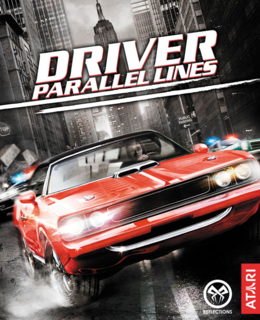Wheelman of New York
Introduction
The Driver series was once held in high regard because it pioneered the concept of a 3D open world game with a city setting before Grand Theft Auto popularized it. The first game in the series, Driver, was an unprecedented hit for PlayStation and ultimately led to a sequels such as Driver 2, which was received less favorably due to technical issues.
Despite the lukewarm reception and further unwanted controversy surrounding the release period of DRIV3R, the series just soldiered on - perhaps due to the publisher Atari SA seeing some sort of potential in the game series - continuing with spin-offs and eventually a standalone sequel called Driver: Parallel Lines in 2006.
This game is a departure from the recurring storyline of series protagonist John Tanner, and instead focuses on a young wheelman known only by the initials T.K. Another feature prominent in previous Driver games, the several diverse cities that can be explored, was omitted for a full-on recreation of New York City as well as parts of New Jersey. A lot of bold moves
Driver: Parallel Lines is a game that I often hear about in many underrated games circles. Here is my review of Reflections Interactive's fourth Driver game, Driver: Parallel Lines.
Positives
As expected, the driving mechanics of Driver: Parallel Lines are just as good if not better than what we got in DRIV3R. Cars have good handling & dynamics, especially the weight on various vehicles that can be driven. Not to mention that there's a huge collection of cars in the game that can be extensively customized and tested on racetracks.
One of the game's lauded mechanics / plot lines is the time shift from 1970s New York to contemporary New York. While I will not mention the reason for the 28-year time gap, I will admit I liked how it was executed. It's quite rare to see many games set in the 70s and its a vibrant era full of character - a perfect fit for an open world game in my opinion.
While New York is a city that has been seen time and time again in games, I can never get enough of it. I've played so many open-world games with a NYC-like setting such as Grand Theft Auto IV and Prototype that I probably know the city more than I do my own. I feel that the New York we see in Driver: Parallel Lines is quite accurate to the real deal for the most part, especially with the amount of traffic on display in the streets - which is impressive for a game on original Xbox hardware.
For the most part, the visuals are great. The cutscenes of Driver: Parallel Lines in particular look really impressive, which is to be expected as previous Driver games (as well as Driver: San Francisco) were known for their stylistic CG cutscenes. It's debatable whether these cutscenes are a product of its time, but you can't deny how much effort was put into making them.
I absolutely admire the soundtrack of this game all across the board. New York in '78 has some really catchy funk, soul and rock music, whereas 2006 New York offers modern hip hop, electronic music and post-punk. A few of my favourite tracks in no particular order include Ghost Rider by Suicide, Tribulations by LCD Soundsystem, and of course, One Way or Another by Blondie.
Negatives
A major gripe of mine is that this game came out at the wrong time, which might have been a factor as to why this game didn't sell as well in comparison to DRIV3R. This game released around the same time as games such as The Elder Scrolls IV: Oblivion and The Godfather: The Game. The point I'm making is that this game may have been more profitable if it also came out on then-current gen systems such as Xbox 360 and PlayStation 3 - but that may have led to issues similar to what we saw with DRIV3Rgate.
One incremental thing that stopped me from fully appreciating Driver: Parallel Lines was the police system. Now I understand that New York is a pretty diverse and congested city and that would obviously mean an abundance of cops roaming the streets, but what really annoyed me was the poor implementation of speed / traffic laws which were not present in previous Driver games to my knowledge (at least not Driver 3). It constantly reminded me of similar gameplay mechanics in the Mafia games, and I got tired of it fast. It's always good to have simulation-style mechanics for racing games, but only if it's optional.
While Driver: Parallel Lines is much more of a complete experience than DRIV3R, it's still not perfect by any means. I would often have issues with audio in-game, particularly looping voice lines from NPCs.
Conclusion
Driver: Parallel Lines is a thrill-chasing, fast-moving diamond in the rough. While not as strong in comparison to games such as Grand Theft Auto: San Andreas and even the True Crime series, it still pertains as a classic open-world racing game due to its sizable library of drivable vehicles, unique plot structure and amazing soundtrack. That's why I give Driver: Parallel Lines a 7/10.
Recommended for:
I would recommend this game for people who enjoy open-world action-adventure games like Grand Theft Auto, are fans of the Driver series or even the Mafia game series.
My recommended pricing for this game would have to be somewhere around £5 - 10.

